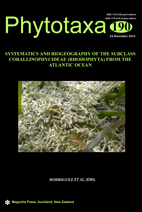Abstract
Coralline red algae demonstrate phenotypic plasticity related to environmental factors, rendering their identification difficult. The cox2-3 spacer is a mitochondrial marker widely used for phylogeographic studies and discrimination between closely related species in red algae; however, cox2-3 spacer sequence data for coralline algae are still limited. In this study we substantially increase the number of cox2-3 spacer sequences available for coralline algae, exploring their usefulness for different types of molecular investigations in coralline algae (DNA barcoding and phylogeography), with emphasis on rhodolith-forming species. Specimens from North Atlantic Europe, the Caribbean region and the Gulf of California (Mexico) were sequenced and two datasets were built, one for the subfamily Lithophylloideae and one for the Melobesioideae. Our results suggest the utility of cox2-3 spacer as barcoding marker for coralline algae with a slight variation in the barcode gap depending in the way gaps in the alignment are treated. Analyses on both datasets found a barcode gap or separation between intra and interspecific divergence (p distance and ABGD analysis) while some inconsistencies were evident when the results were compared with morphology-based classification. Using the cox2-3 spacer region, the morphospecies Lithophyllum margaritae from the Gulf of California revealed the existence of two well-supported clades, with the possibility of respectively five and two additional species; haplotype networks for Phymatolithon calcareum and P. purpureum revealed similar patterns when Mediterranean and NW Europe specimens were analysed, and P. calcareum was shown to consist of a single population in NW Europe. Based on our analyses the marker cox2-3 spacer has strong potential applications for studies of phylogeography and DNA barcoding in coralline algae after understanding its variation.

